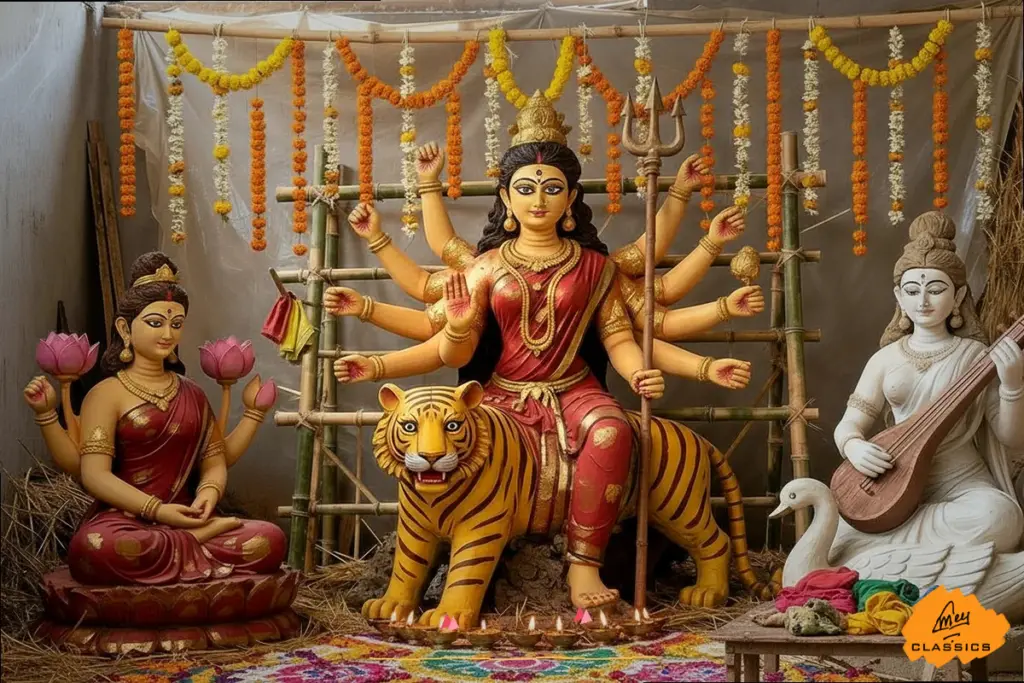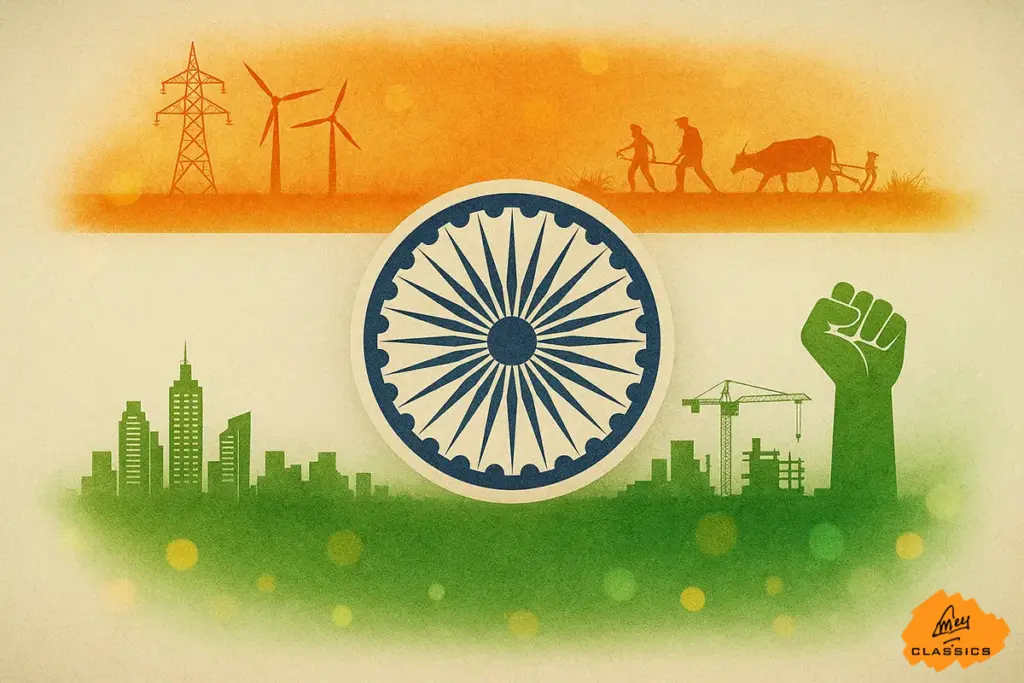
Navratri: A Journey Through the Feminine Mysteries of Life, Power and Liberation
Navratri is not merely a celebration of tradition - it’s a deep symbolic process that mirrors the inner workings of life itself. From invoking strength and abundance to seeking wisdom and transcendence, this nine-night festival reveals the hidden dimensions of existence through the divine feminine. Through this insightful reflection, explore Navratri’s true significance, its inner science, and why this time is not just festive but transformational.
Now available in:
Navratri, a vibrant and deeply symbolic festival in Indian culture, is a celebration that spans nine nights, dedicated to the worship of the divine feminine. This festival, which falls in either September or October, is a time when the entire country comes alive with vibrant colors, dance, music, and devotion.
But beyond the rituals and colors lies a deeper dimension — one that reflects the inner dynamics of human life, nature, and transformation.
The Significance of “Navratri”:
Navratri, a Sanskrit word, is a combination of two words, “Nava” and “Ratri”. “Nava” means nine and “Ratri” means night. So Navratri literally means “nine nights.”
These nine nights begin after Amavasya (the new moon), and they are a period of inner cleansing, renewal, and reverence for the divine feminine — Devi — who represents the fundamental creative force in existence.
There are multiple nine-night periods in a year. One that falls in either September or October is called Shardiya Navratri. You may have heard the word “Shardiya”.
The word “Shardiya” comes from the word “Sarada”, the goddess of learning. This Navratri is considered the most significant one because it is dedicated to Sharada, the goddess of learning.
It’s a time when you should turn inward, seeking to balance your life and transcend your limitations by invoking the goddess’s divine power.
MD Classics | Articles
Receive the latest articles straight to your email inbox by subscribing to the newsletter
The Three Phases of Navratri: A Journey Through Life’s Core Dimensions
Navratri is not a one-day festival. Navratri is divided into three sets of three days, each with a different focus and significance. Durga, Lakshmi and Saraswati are seen as three dimensions of the feminine that symbolize the earth, the sun and the moon.
Days 1–3: Durga – Invoking Strength & Destruction of Negativity
The first three nights are dedicated to Goddess Durga or Kali, symbolizing power, courage, and the destruction of obstacles. This is a time to overcome inertia, lethargy, and the darkness within.
Those who seek power, dynamism, and inner strength turn to this fierce form of Devi.
These three days of Navratri represent the Tamasic quality — associated with the Earth element and the force required to push through resistance.
Days 4–6: Lakshmi – Inviting Prosperity & Passionate Involvement
The next three nights are dedicated to Goddess Lakshmi, the embodiment of prosperity, abundance, and passionate involvement in life.
It’s not just about wealth — it’s about your wholehearted involvement in life’s process.
These three days are characterized by the Rajasic quality, symbolizing passion and activity. Passion essentially signifies your absolute involvement with something. It can be anything; it can be with any activity that you perform. Without any involvement, nothing happens.
Days 7–9: Saraswati – Seeking Knowledge & Inner Clarity
The final three nights are dedicated to Goddess Saraswati, the bringer of wisdom, insight, and higher knowledge.
If you refine this energy within, you don’t just gather information — you awaken deeper knowing.
The final three days of Navratri are associated with the Sattvic quality, representing purity and knowledge. The Sattvic quality during the final three days of Navratri represents life transformation. It guides individuals on a path toward inner peace and self-realization. If you refine this quality, you can attain a deeper connection with the divine and ultimately with your own true self, enabling personal growth and a more profound understanding of the world.
Day 10: Vijayadashami – Transcending the Cycle
The tenth day, which is referred to as Vijayadashami, signifies the victory over all these three aspects of life.
This victory isn’t external. It’s about:
- Moving beyond the Tamasic darkness of inertia,
- Integrating the Rajasic fire of action,
- And arriving at Sattvic clarity — a space of inner liberation.
Breaking the Cyclical Pattern of Life:
You can also look at this from a different perspective. It is like, as human beings, we come from this earth and become active for some time. And after a while, we return back to this earth.
That means we emerge from a state of inertia, become dynamic for a while & again we dissolute ourselves into the inertia.
This is not just happening for human beings; this same thing is happening for every creature on this planet. The entire universe is working like this in a cyclical process.
The first two forms of Devi signify this cyclical process & the last form signifies breaking this cyclical process & to liberate yourself from this cyclical pattern.
Navratri becomes a metaphor: you don’t have to remain a part of the cycle. You can transcend it.
Celebrating The Feminine:
When we say masculine & feminine, we are not referring to male or female on a gender basis. We are referring to the masculine & feminine qualities of a human being.
As masculine brings certain types of qualities & values into our lives, feminine also brings other types of values & qualities into our lives. Masculine brings structure, direction, and assertion. Feminine brings nurturing, creativity, and receptivity.
These polarities exist in everything. It symbolizes the two essential dimensions of creation. Masculine-feminine, positive-negative, dark-light, clockwise-anticlockwise. One is not superior to the other. Together, they create balance.
Navratri is a powerful reminder of the feminine aspect of life — often forgotten, yet foundational.
Honoring the Feminine Energy:
Navratri underscores the importance of the feminine principle, which is not limited to gender but encompasses the nurturing, creative, and transformative forms of the planet.
During the festival, people set up elaborate altars with idols or images of various goddesses, adorned with flowers, lamps, and other offerings.
But these aren’t just rituals — they are symbolic actions to invoke what lies within.
Rituals are reminders, not rules. They exist so you don’t forget what you’re truly looking for.
Celebrating Navratri:
Navratri is a festival that encapsulates the diversity and depth of the human system and its relationship with the planetary system. It is a time when you come together to seek the blessings of the divine feminine energy, celebrating the victory of good over evil and the transcendence of darkness by light.
This is the fundamental nature of Navratri — something to celebrate and enjoy, but not something to fully grasp. It’s a beautiful mystery you can enter, but not decode.
Navratri isn’t a concept to be mastered. It’s a mystery to be experienced.
It holds layers that cannot be fully explained — only touched through involvement and devotion.



